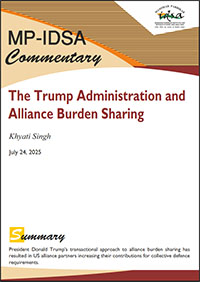The Trump Administration and Alliance Burden Sharing
- July 24, 2025 |
- IDSA Comments
The North Atlantic Treaty Organization (NATO) has been a crucial military alliance of the United States, formed at the start of the Cold War in 1949. The core principle articulated in Article 5 of NATO is collective defence, implying that an armed attack against any NATO member would be considered an attack on all and, therefore, retaliated against collectively. Unlike other alliances that faded into history at the end of the Cold War, NATO has survived, thrived and expanded to include 32 states in 2024.
The budgeting requirements of NATO’s collective defence are met through direct contributions, indirect contributions and joint funding. Direct contributions are the funds that NATO member states allocate to meet the organisational and infrastructural needs. This fund covers military infrastructure administrative costs, among other aspects. The contributions are based on a formula that ensures larger economies pay more based on the member states’ Gross National Income (GNI).[1]
The most significant funding comes from indirect contributions, consisting of states’ military expenditure for their defence. These funds are not sent to NATO directly but are spent by states to improve their defence capabilities. The joint funding mechanism relates to project-specific collaboration and involves pooling resources for shared objectives. This may include joint operations, research and development (R&D) for developing military equipment, and security projects. Joint funding is spent on projects requiring huge investments, which cannot be borne by one member country alone.
Several projects operate from this funding, such as the NATO Airborne Early Warning and Control Management Agency (NAPMA), NATO Helicopter Management Agency (NAHEMA), NATO Eurofighter and Tornado Management Agency (NETMA), the Defence Innovation Acceleration for North Atlantic (DIANTA) and NATO Innovative Fund for developing dual-use technology.[2]
At the 2014 Wales Summit, NATO members committed to spend a minimum of 2 per cent of their GDP on defence, with 20 per cent of the sanctioned budget dedicated to defence equipment purchases. Although this commitment is not legally binding, it has become a bone of contention between President Donald Trump and NATO members. During his first term, Trump termed NATO “obsolete” and threatened to withdraw from the organisation if member states failed to meet the 2 per cent spending targets.[3]
Trump has insisted that NATO members pay their fair share to protect the mutual interests.[4] At the NATO 2018 Summit in Brussels, Trump accused Germany of its energy dependence on Russia and warned NATO leaders that the US would “go our own way” if the spending targets were unmet.[5] As President-elect in 2024, at a South Carolina rally, Trump remarked that he had warned a NATO ally to spend more on defence, failing which he threatened that the US “would not protect you”.[6]
NATO has also been cognizant of the need to meet its defence needs in the face of growing challenges from cybersecurity, terrorism and geopolitical challenges from states such as Russia and China. NATO Secretary General Jens Stoltenberg at The Brussels Forum in 2020 stressed that increased defence investment by NATO member states supports military readiness.[7] Given the geo-political challenges and pressure from Trump, NATO’s defence spending has risen.
As per SIPRI, the combined military expenditure of NATO members has grown substantially from US$ 1120 billion in 2015 to US$ 1506 billion in 2024. The US remains the dominant contributor despite witnessing a decline in its share.[8] Following Trump’s threat of withdrawal, there has been some momentum in Europe’s contribution to NATO defence spending, reaching 30 per cent in 2024 from 28 per cent in 2023, while the average defence budget of NATO members reached 2.2 per cent.[9]
SIPRI’s 2023 data suggests that NATO members account for 55 per cent of the world’s arms spending, estimated at US$ 1.4 trillion. The US alone accounted for 37 per cent of US$ 916 billion, while Germany spent US$ 66.8 billion.[10] The most dramatic shift among NATO countries was by Lithuania, which rose by 324 per cent from 2015 to 2024.[11] At the 2025 NATO Summit in Hague, all member states agreed to increase their defence spending to 5 per cent of GDP.
A part of the reason for the renewed enthusiasm and acceptance of Trump’s demands was the Russia–Ukraine war. This coerced small states into contributing towards the collective security umbrella of NATO. In 2024, 23 out of 32 NATO members met the 2 per cent goal against just 11 in 2023.[12] Besides indirect cost sharing, the Trump administration has also worked to re-balance NATO’s internal cost sharing. In 2019, members agreed on a new cost-sharing formula, thereby reducing the US share from 22 per cent to nearly 16 per cent, the same as Germany’s.[13] This was deemed a concession against Trump’s demand for fair burden sharing.
Apart from the need for greater burden sharing by NATO, the Trump administration announced in June 2025 a formal review of AUKUS, the 2021 trilateral security pact between Australia, the UK and the US.[14] The main aim of this review was to analyse whether the commitments under this pact delivered proportionate benefits. Furthermore, Defence Secretary Pete Hegseth publicly made a striking demand from Australia, asking it to increase its defence spending from 2 per cent to 3.5 per cent.[15]
As part of the AUKUS deal, Australia has committed to spending nearly US$ 245 billion over the next 30 years to induct nuclear-powered submarines. The Australian government has also approved an investment of US$ 7.7 billion to develop nuclear submarine infrastructure in the country. While Australia covers all the financial costs, the UK and the US contribute primarily through technology transfers, industrial expertise and design collaboration. Under the AUKUS partnership, the US has committed to delivering five Virginia-class submarines to Australia starting from 2032.[16]
While AUKUS is not a mutual defence treaty but a high-technology procurement agreement, Trump has demanded that Australia speed up its spending (up to 3.5 per cent) and shoulder a significant share of Western Indo-Pacific defence. Australia is undoubtedly increasing its defence spending as it requires the US security umbrella amidst the growing threat of China. The federal defence budget of Australia for 2024–2025 stood at nearly US$ 37 billion, including several investments for long-range strike capabilities, cyber warfare and the AUKUS submarine infrastructure.[17]
Conclusion
Trump’s terms in office have intensified the discussions among European nations about their strategic dependence on the United States. France has been advocating for a permanent EU military headquarters. At the same time, the European Council established the Military Planning and Conduct Capability (MPCC) in 2017 to coordinate non-executive operations, thus reflecting Europe’s growing ambition for defence autonomy.
Trump’s policies towards alliances have also triggered domestic responses. US Congressional leaders sought to make it difficult for any US President to quit NATO, for instance, through an executive decision. The then-Senate Armed Services Chairman Senator Marco Rubio and Democratic Senator Tim Kaine proposed legislation to legally bar any President from leaving NATO without Congressional approval. An amendment was approved by Congress in 2023 requiring two-thirds Senate approval for any withdrawal.[18]
Congress also conducted several hearings on burden sharing, inviting experts who testified that the US credibility would be undermined if the Trump administration continued its approach towards critical alliances such as NATO.[19] Domestic surveys, such as those by the Chicago Council, show that most of the public supports NATO. While Republican voters acknowledge that the US should spend less, they prefer a balanced relationship with the allies.[20] However, Trump’s transactional approach to alliance burden sharing has undoubtedly resulted in US alliance partners increasing their contributions for collective defence requirements.
Views expressed are of the author and do not necessarily reflect the views of the Manohar Parrikar IDSA or of the Government of India.
[1] “Funding NATO”, North Atlantic Treaty Organization (NATO), 27 June 2025.
[2] “Item 1217 – A Layman’s Guide to NATO (Common) Funding”, NATO, 11 May 2023.
[3] “Trump Worries Nato with ‘Obsolete’ Comment”, BBC News, 16 January 2017.
[4] “NATO Countries Must Pay ‘Fair Share’ Before Enlarging Alliance: US Envoy”, NEWS18, 23 January 2017.
[5] Jeremy Diamond, “NATO Summit: Trump Accuses Germany of Being a ‘Captive of Russia’”, CNN Politics, 11 July 2018.
[6] Jill Colvin, “Trump Says He Told NATO Ally to Spend More on Ddefense Or He Would ‘Encourage’ Russia to ‘Do Whatever the Hell They Want”, PBS News, 11 February 2024.
[7] “Remarks by NATO Secretary General Jens Stoltenberg at the Brussels Forum”, NATO, 23 June 2020.
[8] “Trends in World Military Expenditure, 2024”, Stockholm International Peace Research Institute (SIPRI), April 2025.
[9] Ibid., p. 4.
[10] “SIPRI Military Expenditure Database”, SIPRI, 2024.
[11] “NATO Spending by Country 2025”, World Population Review, 2025.
[12] “Record 23 Countries Hit 2 percent Defense Spending Target, NATO Says”, Politico, 18 June 2024.
[13] “US to Cut Spending on NATO Budget Under New Cost-sharing Formula”, i24, 28 November 2019.
[14] Mallory Shelbourne, “Defense Department Conducting Review of AUKUS Security Pact”, USNI News, 11 June 2025.
[15] Jake Evans, “US Demands Australia Lifts Defence Spending by $40b a year ‘as soon as possible”, ABC News, 2 June 2025.
[16] Euan Graham, “Don’t Panic: The US AUKUS Review Could Strengthen the Partnership”, The Strategist, 13 June 2025.
[17] Gordon Arthur, “Australia Unveils Record $37 billion Defense Budget”, DefenseNews, 15 May 2024.
[18] “Kaine & Rubio Applaud Senate Passage of Their Bipartisan Bill to Prevent Any U.S. President from Leaving NATO”, Tim Kaine—US Senator from Virgina, 13 December 2023.
[19] “Hearings to Examine Indo-Pacific Alliances and Burden Sharing in Today’s Geopolitical Environment”, Senate Foreign Relations Committee, Congress.gov, 26 March 2025.
[20] “Poll: U.S. Public Opinion on Foreign Policy Pivots to Europe, Unites on Ukraine Support”, The Chicago Council on Global Affairs, Yahoo!finance, 20 October 2022.






